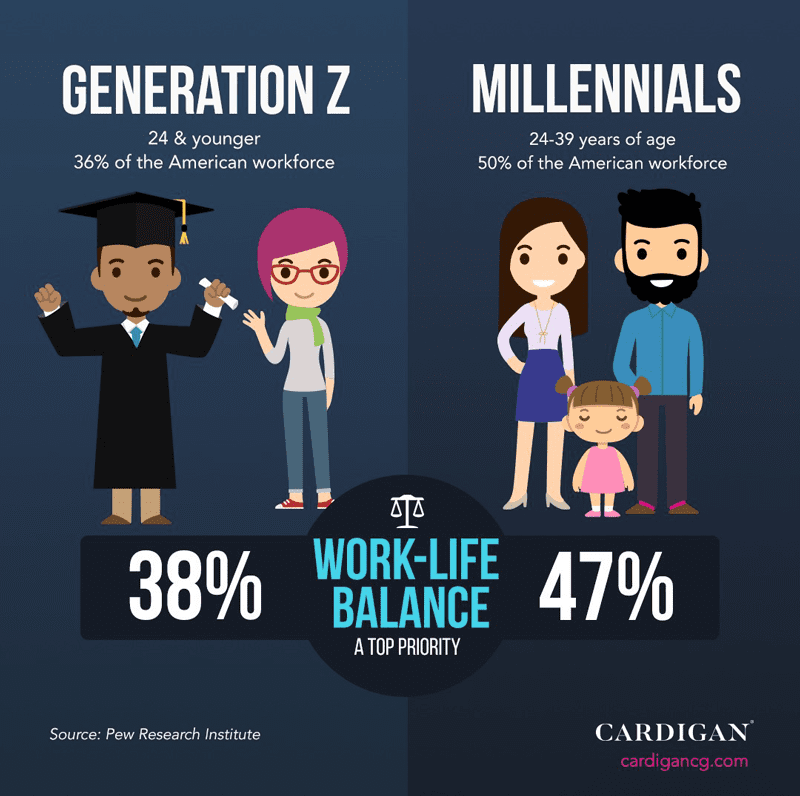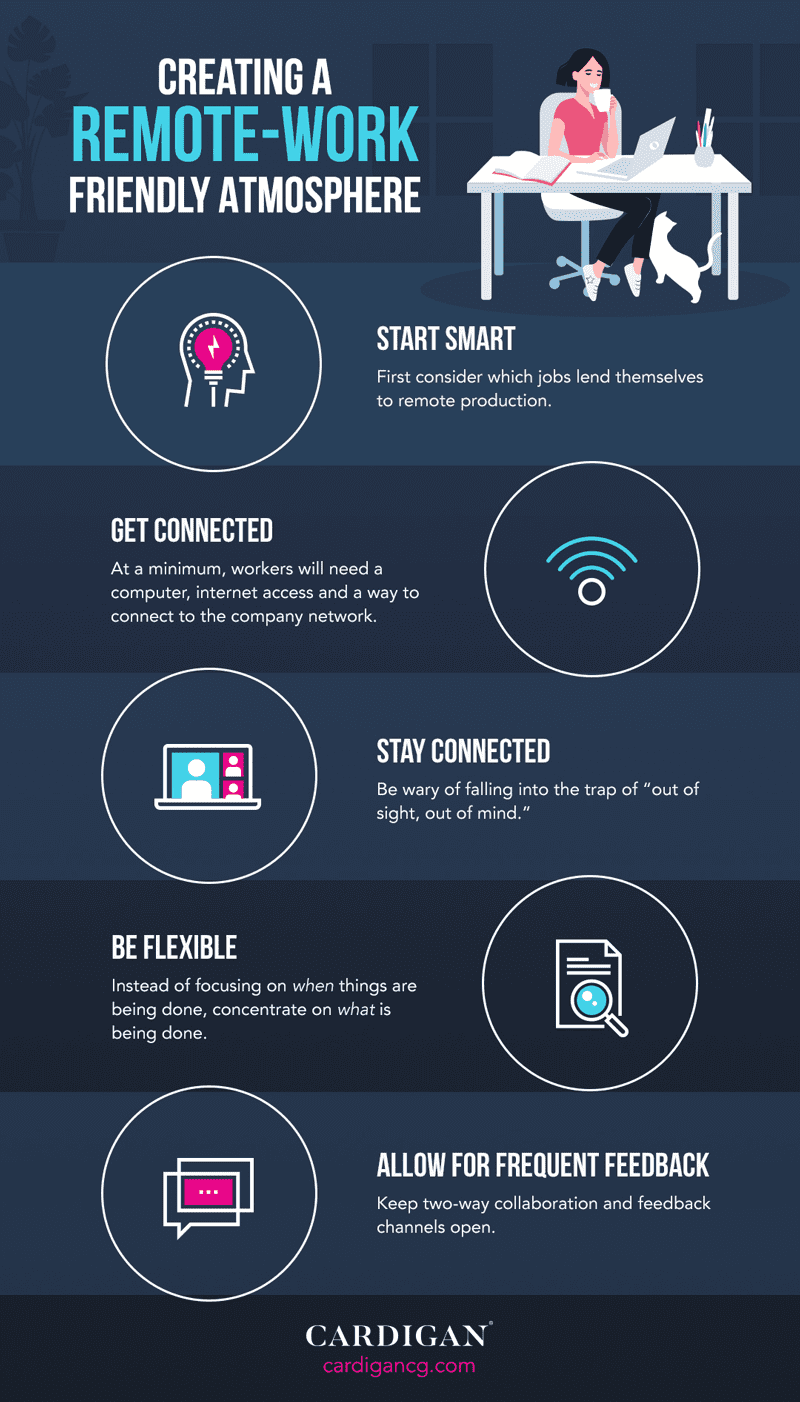With the majority of the U.S. workforce currently “sheltered in place,” remote work has now become the new norm. With only a day or two notice, organizations were forced to send their employees home and quickly set up work from home protocols. We truly are finding out that meeting could have been an email or, at the very least, a video conference.
Temporarily gone are the long commutes and the expectation to be in the office and at a desk from nine to five. With this newfound extra time on their hands, employees are shifting their schedules to allow for self-care with at-home workouts, they’re enjoying meals with their family members, and are learning the other benefits that come with the flexibility working from home offers.
In a post-COVID-19 world, when we are able to safely venture out once again, employees will be looking for employers who can continue to provide the work/life balance to which they have come accustomed, especially those employees who make up the bulk of the American workforce – millennials (50 percent) and Generation Z (36 percent).
Generation Z versus Millennials
Generation Z, age 24 or younger, is the newest generation to enter the professional workforce. While many still mistakenly assume that their predecessor, millennials, are college-age students, that just isn’t true. According to The Pew Research Institute, (https://www.pewresearch.org/fact-tank/2019/01/17/where-millennials-end-and-generation-z-begins/) millennials include anyone from 24-39 years of age. Long story short, they are already in the workforce, some married, and some with children.
Though there are some marked differences between these two generations, there are also some similarities, namely when it comes to savvy with technology, what they look for in an employer, and a high value placed on work/life balance, or remote work opportunities.

For organizations that have been traditionally office-bound, such as those in the oil and gas industry, this can be a bit of a cultural shift, but it is imperative that employers in all industries offer remote work opportunities in order to continue to grow and be successful.
Start Smart
While you may be tempted to immediately put into place an enterprise-wide remote work policy, it would actually behoove companies to first consider which jobs lend themselves to remote production. For example, employees who deal face-to-face with customers, serve in boots-on-the-ground roles, or work closely within a team may not be able to perform effectively at home. Having a plan to shift work of that nature to remote work during times of crisis is smart, but may not be ideal for business-as-usual operations.
If you’re truly not sure where to start, begin with a beta test of trusted employees to help set up processes and procedures for at home work. Not only will they provide valuable feedback, but it will also help you work out any kinks before rolling out to other areas.
Exempt positions typically lend themselves to remote work easier than non-exempt/hourly roles, but the same technology you use to track hours can be modified for at-home work. However, be sure you understand state and federal compensation rules, especially for non-exempt workers, before allowing employees to work from home.
Finally, keep in mind that remote work does not need to be an all-or-nothing proposition for your employees. You can put in-person parameters in place around important meetings and presentations while still fostering a remote culture and allowing your employees to be flexible with their in-office time – placing the onus on them to determine what work they can do just as effectively at home. This gives them the opportunity to spend time with family or take care of other priorities while still giving attention to work demands and also establishing a trusting relationship between the organization and employee.
Get Connected
There are some logistical considerations when allowing your employees to work from home. At a minimum, workers will need a computer or laptop with internet connectivity and a way to sign on to the company network, giving them access to important resources such as email, intranet, video-conferencing technology, and common drives while allowing you to communicate and monitor work product. You may also want to establish a dedicated phone line or utilize call-forwarding technology. Companies can either provide their employees with the necessary equipment – in fact some do this with the requirement that organizational resources only be accessed via company-allocated devices – or you can require that employees have the necessary technology available (e.g., computer, cell phone) to be eligible for a remote work position.
Stay Connected
With a remote workforce, be wary of falling into the trap of “out of sight, out of mind.” While both millennials and Generation Z are incredibly digitally-oriented generations, humans crave interaction and collaboration, even at work. In fact, our research has shown that one of the biggest complaints of remote workers is the feeling of being on an island.
Much of the communication with your remote workforce may be via email, but it is important to check in through other means. Video chats are a great way to have face-to-face time. Schedule weekly one-on-ones as well as team video conferences where you can discuss matters and brainstorm about projects that may be harder to convey through email or text. Build in time to allow for water cooler talk or begin team meetings by allowing everyone to share “something good” that may or may not have anything to do with work. Celebrate birthdays, work anniversaries, and professional accomplishments. If possible, schedule a teambuilding retreat, either quarterly or bi-annually, so that your team can meet in person. This is all part of human connection that allows your employees to form personal bonds.
For managers of remote teams, daily touchpoints are also important. The personal preferences of their individual team members may vary. For example, a Generation Z employee may prefer a quick video chat while a millennial would prefer a call or text message. A best practice is to send a short survey asking team members about their preferences for communication including vehicle (i.e., phone call or video chat), best times to talk, and even preferences on how they like to be recognized. Organizations can also send surveys periodically as a touchpoint to gauge how employees are feeling and to identify areas of opportunity when it comes to communication and connectedness.
Be Flexible
With your exempt remote workforce, it’s important to focus on the goals accomplished versus hours worked. Remember, part of the allure of working from home is flexibility. It allows employees to care for their family or other important matters, so don’t expect them to adhere to a standard nine to five. Schedule flexibility lets your employees work at their most productive times. Instead of focusing on when things are being done, have trust in your people and concentrate on what is being done.
Use your communication channels and virtual team meetings to make sure the whole team is on the same page, on task, and clear about each of their responsibilities. Set weekly/quarterly goals or benchmarks, and track progress toward them. There are multiple virtual project management tools teams can use to assist with this. If employees are meeting their deadlines and goals, and their work product is meeting expectations – great! If not, just as with your in-office employees, it’s time to look into why. It could be as simple as needing access to a tool or a talent development opportunity with training and coaching.
Allow for Frequent Feedback
Gone are the days of the bi-annual performance appraisal or giving feedback only when things are going wrong. Reviews should never include surprising information. With today’s workforce, that just won’t fly. Think of the many informal touchpoints and opportunities to quickly bounce an idea off of someone you have when you physically sit next to or near a coworker or employee. With a remote workforce, it’s equally as important to keep frequent two-way collaboration and feedback channels open, both between team members and employee and manager.
In fact, your Generation Z employees not only value frequency with feedback, they value measurability. This means specific, actionable, and trackable feedback. Your millennial employees value open and honest two-way communication, so even remote managers should strive to have an “open door” policy.

In a time where organizations are competing for top talent – assuming salary and benefits can be matched by any of your competitors – a corporate culture that allows work flexibility and remote work opportunities can set you apart and make your company more appealing to work for. Not to mention, it opens up your candidate pool. Instead of hiring for people in a specific region or city, you can hire for talent, no matter where they are physically located.
The key to success with a remote workforce is being smart about the roles you offer remotely, then getting connected and staying connected with frequent feedback and collaboration channels, focusing less on hours worked and more on productivity of your remote teams.
Dr. Harold Hardaway is a speaker and thought leader on corporate communications and culture. He believes that everyone should “Chase the Good” and centers his work on helping organizations create spaces where that’s possible. He was previously the Director of Corporate Communications and Culture for H-E-B, and today, he serves as Co-Founder and CEO of Cardiganand oversees research and strategy for all client projects.
Shannon is a gifted communication and marketing strategist who has made a name for herself creating game-changing communication & health and wellness initiatives that facilitate organizational and personal growth for some of Texas’ most beloved brands. Today, she serves as Chief Creative Officer for Cardigan and oversees creative and video production for all client initiatives, she also puts her passion for health to work as a Certified Health Coach, leading up the development of Health & Wellness Programming.






